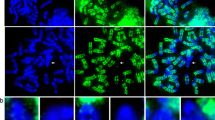Abstract
The structural gene for proliferating cell nuclear antigen (Pcna) has been mapped to mouse Chromosome (Chr) 2 by use of a PCR-based assay. With somatic cell hybrids, Pcna was mapped between the T(2;4)13H and T(2;4)1Sn breakpoints. An interspecific backcross was employed to map Pcna 1.9±1.3 cM distal to Il-lb. This was confirmed by mapping Pcna in the BXH recombinant inbred (RI) strains; no recombinants were seen between Il-la and Pcna. In addition, a PCNA-related sequence (Pcna-rsl) was mapped to Chr 19 in the BXH RI strains.
Similar content being viewed by others
References
Aitman, T., Hearne, C., McAleer, M., and Todd, J.: Mononucleotide repeats are an abundant source of length variants in mouse genomic DNA. Mammalian Genome 1: 206–210, 1991.
Almendral, J., Huebsch, D., Blundell, P., McDonald-Bravo, H., and Bravo, R.: Cloning and sequence of the human nuclear protein cyclin: homology with DNA-binding proteins. Proc Natl Acad Sci USA 84: 1575–1579, 1987.
Bravo, R. and McDonald-Bravo, H.: Induction of the nuclear protein ‘cyclin’ in quiescent mouse 3T3 cells stimulated by serum and growth factors. Correlation with DNA synthesis. EMBO J 3: 3177–3181, 1984.
Davisson, M.T., Lalley, P.A., Peters, J., Doolittle, D.P., Hillyard, A.L., and Searle, A.G.: Report of the comparative committee for human, mouse and other rodents (HGM11). Cytogenet Cell Genet 58: 1152–1189, 1991.
D'Eustachio, P., Jadidi, S., Fuhlbrigge, R., Gray, P., and Chaplin, D.: Interleukin-1 α and β genes: linkage on chromosome 2 in the mouse. Immunogenetics 26: 339–343, 1987.
Falconer, D.: Linkage in the mouse: the sex-linked genes and ‘rough’. Z Indukt Abstammungs-Vererbungsl 86: 263–268, 1954.
Green, M., Sweet, H., and Bunker, L.: Tight-skin, a new mutation of the mouse causing excessive growth of connective tissue and skeleton. Am J Pathol 82: 493–512, 1976.
Hogarth, P., Houlden, B., Latham, S., Cherry, M., Taylor, B., and McKenzie, I.: The mouse Ly-12.1 specificity: genetic and biochemical relationship to Ly-1. Immunogenetics 27: 383–387, 1988.
Jaskulski, D., deRiel, J., Mercer, W., Calabretta, B., and Baserga, R.: Inhibition of cellular proliferation by antisense oligodeoxynucleotides to PCNA Cyclin. Science 240: 1544–1546, 1988.
Ku, D., Travali, S., Calabretta, B., Huebner, K., and Baserga, R.: Human gene for proliferating cell nuclear antigen has pseudogenes and localizes to chromosome 20. Somatic Cell Mol Genet 15: 297–307, 1989.
Lane, P. and Green, M.: Mahogany, a recessive colour mutation in linkage Group V of the mouse. J Hered 51: 228–230, 1960.
Love, J., Knight, A., McAleer, M., and Todd, J.: Towards construction of a high resolution map of the mouse genome using PCR-analysed microsatellites. Nucleic Acids Res. 18: 4123–4130, 1990.
Pilz, A., Fox, M., Povey, S., and Abbott, C.: A panel of somatic cell hybrids with translocation breakpoints on mouse chromosome 2 and their characterization by PCR. Mammalian Genome 1 (Suppl): S517, 1991.
Pilz, A., Moseley, H., Peters, J. and Abbott, C.: Comparative mapping of mouse chromosome 2 and human chromosome 9q: the genes for gelsorin and dopamine β hydroxylase map to mouse chromosome 2. Genomics 12: 715–719, 1992.
Sakaguchi, A., Martinez, L., Lalley, P., Sylvia, V., Han, E., Killary, A., and Ghosh Choudhury, G.: Chromosome mapping in mouse of genes that regulate the eukaryotic cell cycle. Cytogenet Cell Genet 58: 2138, 1991.
Siracusa, L. and Abbott, C.: Mouse Chromosome 2. Mammalian Genome: 1: S15-S41, 1991.
Webb, G., Parsons, P., and Chenevix-Trench, G.: Localization of the gene for human proliferating cell nuclear antigen/cyclin by in situ hybridization. Hum Genet 86: 84–86, 1990.
Yamaguchi, M., Nishida, Y., Moriuchi, T., Hirose, F., Hui, C-C., Suzuki, Y., and Matsukage, A.: Drosophila proliferating cell nuclear antigen (cyclin) gene: structure, expression during development, and specific binding of homeodomain proteins to its 5′ flanking region. Mol Cell Biol 10: 872–879, 1990.
Yamaguchi, M., Hayashi, Y.Y., Hirose, F., Matsuoka, S., Moriuchi, T., Shiroishi, T., Moriwaki, K., and Matsukage, A.: Molecular cloning and structural analysis of mouse gene and pseudogenes for proliferating cell nuclear antigen. Nucleic Acids Res 19: 2403–2410, 1991.
Author information
Authors and Affiliations
Rights and permissions
About this article
Cite this article
Abbott, C., Pilz, A., Moseley, H. et al. The gene for proliferating cell nuclear antigen (Pcna) maps to mouse Chromosome 2. Mammalian Genome 3, 286–289 (1992). https://doi.org/10.1007/BF00292157
Received:
Accepted:
Issue Date:
DOI: https://doi.org/10.1007/BF00292157




